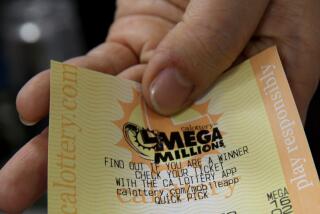SEC Letting Nasdaq Turn to Sweet 16ths on Monday
- Share via
NEW YORK — The Nasdaq stock market will begin quoting all share prices in sixteenths of a dollar Monday, a move that Nasdaq officials said would help investors find better prices and potentially reduce their transaction costs.
The Securities and Exchange Commission, which regulates stock markets, Tuesday gave Nasdaq permission to make the change from the current minimum price increment of one-eighth of a dollar, or 12.5 cents.
The American Stock Exchange began quoting all of its stocks in sixteenths (6.25 cents) on May 7.
Nasdaq and Amex--the nation’s second- and third-largest stock markets, respectively--were already using sixteenths for quotes on stocks trading at less than $10 a share; the changes extend the rule to all shares sold in the two markets.
The New York Stock Exchange, the No. 1 stock market in trading volume, uses increments of one-eighth for all stocks and has no plans to change.
“Decreasing the minimum quotation increment should help to produce more accurate pricing of . . . securities and can result in tighter quotations,” the SEC said in its approval order, signed by secretary Jonathan G. Katz.
SEC and Nasdaq officials said the move to sixteenths should also help narrow the “spreads” between bid and asked (“sell” and “buy”) prices, lowering transaction costs to investors.
Nasdaq spreads have already shrunk 31% since Jan. 20, when the SEC introduced new trading rules for the market, Nasdaq announced Wednesday.
Nasdaq officials acknowledged, though, that if spreads--which constitute the dealer’s price markup--get much tighter, dealers may recoup their losses by tacking on straight sales commissions.
Some see the shrinking of the minimum-price increment as a step toward abandoning fractions entirely and quoting stocks in plain dollars and cents.
Rep. Michael G. Oxley (R-Ohio) is leading a drive in Congress to require dollars-and-cents stock pricing on all U.S. exchanges. The legislation cleared his subcommittee on Commerce, Trade and Hazardous Materials last week.
While quoting in sixteenths may save investors money, Oxley believes that it thwarts another key goal of his decimal-pricing bill: making the markets more understandable to ordinary investors.
“This narrows spreads and, in that sense, is a step in the right direction,” Oxley aide Peggy Peterson said Wednesday. “But in terms of understandability, it’s even worse.”
If most investors can’t quickly convert, say, three-eighths into 37.5 cents, even fewer will be comfortable with fractions like five-sixteenths, or 31.25 cents, she said.
It is important to differentiate between the prices quoted for stocks and those at which stocks actually trade. In large transactions, dealers and their institutional customers often negotiate per-share prices down to sixteenths of a dollar, pennies, and even smaller increments, such as 1/256 of a dollar (0.39 cents).
However, until these recent changes, quoted prices--those displayed to the whole market--have never been in smaller increments than one-eighth.
More to Read
Inside the business of entertainment
The Wide Shot brings you news, analysis and insights on everything from streaming wars to production — and what it all means for the future.
You may occasionally receive promotional content from the Los Angeles Times.










